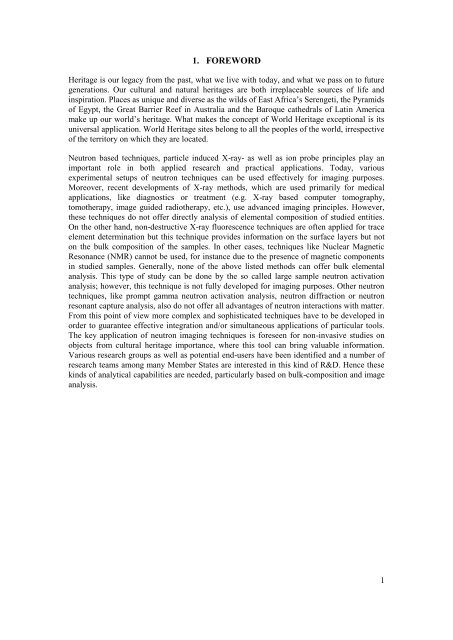Meeting report (pdf) - Nuclear Sciences and Applications - IAEA
Meeting report (pdf) - Nuclear Sciences and Applications - IAEA
Meeting report (pdf) - Nuclear Sciences and Applications - IAEA
Create successful ePaper yourself
Turn your PDF publications into a flip-book with our unique Google optimized e-Paper software.
1. FOREWORD<br />
Heritage is our legacy from the past, what we live with today, <strong>and</strong> what we pass on to future<br />
generations. Our cultural <strong>and</strong> natural heritages are both irreplaceable sources of life <strong>and</strong><br />
inspiration. Places as unique <strong>and</strong> diverse as the wilds of East Africa’s Serengeti, the Pyramids<br />
of Egypt, the Great Barrier Reef in Australia <strong>and</strong> the Baroque cathedrals of Latin America<br />
make up our world’s heritage. What makes the concept of World Heritage exceptional is its<br />
universal application. World Heritage sites belong to all the peoples of the world, irrespective<br />
of the territory on which they are located.<br />
Neutron based techniques, particle induced X-ray- as well as ion probe principles play an<br />
important role in both applied research <strong>and</strong> practical applications. Today, various<br />
experimental setups of neutron techniques can be used effectively for imaging purposes.<br />
Moreover, recent developments of X-ray methods, which are used primarily for medical<br />
applications, like diagnostics or treatment (e.g. X-ray based computer tomography,<br />
tomotherapy, image guided radiotherapy, etc.), use advanced imaging principles. However,<br />
these techniques do not offer directly analysis of elemental composition of studied entities.<br />
On the other h<strong>and</strong>, non-destructive X-ray fluorescence techniques are often applied for trace<br />
element determination but this technique provides information on the surface layers but not<br />
on the bulk composition of the samples. In other cases, techniques like <strong>Nuclear</strong> Magnetic<br />
Resonance (NMR) cannot be used, for instance due to the presence of magnetic components<br />
in studied samples. Generally, none of the above listed methods can offer bulk elemental<br />
analysis. This type of study can be done by the so called large sample neutron activation<br />
analysis; however, this technique is not fully developed for imaging purposes. Other neutron<br />
techniques, like prompt gamma neutron activation analysis, neutron diffraction or neutron<br />
resonant capture analysis, also do not offer all advantages of neutron interactions with matter.<br />
From this point of view more complex <strong>and</strong> sophisticated techniques have to be developed in<br />
order to guarantee effective integration <strong>and</strong>/or simultaneous applications of particular tools.<br />
The key application of neutron imaging techniques is foreseen for non-invasive studies on<br />
objects from cultural heritage importance, where this tool can bring valuable information.<br />
Various research groups as well as potential end-users have been identified <strong>and</strong> a number of<br />
research teams among many Member States are interested in this kind of R&D. Hence these<br />
kinds of analytical capabilities are needed, particularly based on bulk-composition <strong>and</strong> image<br />
analysis.<br />
1
















